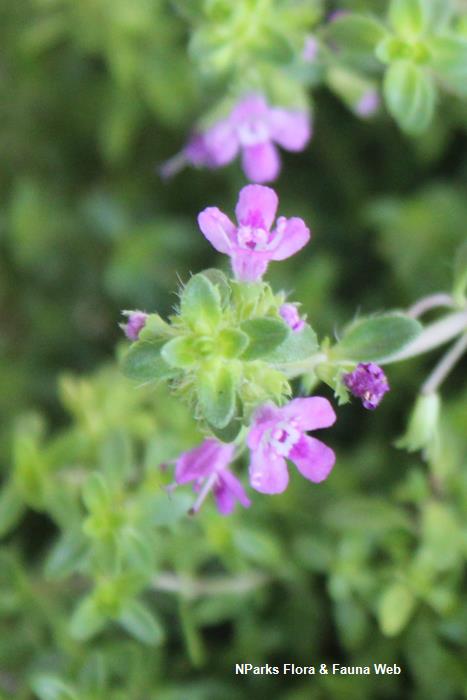
Back
Thymus vulgaris L.
| Family Name: | Lamiaceae (Labiatae) |
| Synonyms: | Origanum thymus, Thymus collinus |
| Common Name: | Thyme, Garden Thyme, Common Thyme, English Thyme |
Name
Classifications and Characteristics
| Plant Division | Angiosperms (Flowering Seed Plants) (Dicotyledon) |
|---|---|
| Plant Growth Form | Shrub |
| Lifespan (in Singapore) | Perennial |
| Mode of Nutrition | Autotrophic |
| Maximum Height | 15 cm to 30 cm |
| Maximum Plant Spread / Crown Width | 15 m to 30 m |
Biogeography
| Native Distribution | Portugal to Greece |
|---|---|
| Native Habitat | Terrestrial |
| Preferred Climate Zone | Mediterranean |
| Local Conservation Status | Non-native (Horticultural / Cultivated Only) |
Description and Ethnobotany
| Growth Form | Perennial with creeping or erect stems up to 0.5 m tall. |
|---|---|
| Foliage | Paired leaves are linear to elliptic with entire leaf margin (3-8 mm long, 0.5-2.5 mm wide). Leaf surface is tomentose, being densely matted with soft hairs. |
| Stems | The base of the stem becomes woody over time. |
| Flowers | Light purple flowers are tubular and 2-lipped. They are arranged in whorls along a spike inflorescence. |
| Fruit | The fruit is composed of 4 one-seeded nutlets which are brown and round (1 mm wide). |
| Cultivation | Seeds may take 14 – 21 days to germinate. Grow it in a sunny location and well-drained soil. Allow the soil between watering sessions to minimise root rot due to overwatering. |
| Ethnobotanical Uses | Edible Plant Parts : Edible Leaves Food (Herb or Spice): The leaves are used to flavour dishes with eggs, beans and tomatoes. Medicinal: The essential oil was clinically shown to have anti-microbial activity, especially when extracted from flowering plants (Marino et al 1999). |
Landscaping Features
| Landscape Uses | Groundcover, Container Planting |
|---|---|
| Thematic Landscaping | Economic Garden |
Plant Care and Propagation
| Light Preference | Full Sun |
|---|---|
| Water Preference | Little Water |
| Rootzone Tolerance | Well-Drained Soils, Easy to Grow |
Foliar
| Mature Foliage Colour(s) | Green |
|---|---|
| Mature Foliage Texture(s) | Velvety / Furry / Tomentose |
| Foliar Type | Simple / Unifoliate |
| Foliar Arrangement Along Stem | Opposite |
| Foliar Attachment to Stem | Petiolate |
| Foliar Shape(s) | Non-Palm Foliage (Elliptical, Linear) |
| Foliar Venation | Pinnate / Net |
| Foliar Margin | Entire |
| Foliar Apex - Tip | Acute |
| Foliar Base | Rounded / Obtuse |
Fruit, Seed and Spore
| Mature Fruit Colour(s) | Brown |
|---|---|
| Fruit Classification | Simple Fruit |
| Fruit Type | Indehiscent Dry Fruit , Nut / Nutlet |
| Seed Quantity Per Fruit | Few (1-5) |
Image Repository
Others
| Master ID | 31006 |
|---|---|
| Species ID | 5393 |
| Flora Disclaimer | The information in this website has been compiled from reliable sources, such as reference works on medicinal plants. It is not a substitute for medical advice or treatment and NParks does not purport to provide any medical advice. Readers should always consult his/her physician before using or consuming a plant for medicinal purposes. |








